Perhaps the title of this post caught your attention. We are painting the front door? Well, maybe.
Andy and I have been working on the front door, on-and-off, since the summer of 2015. Probably the most important post that we wrote was how ice dams damaged the door and how we fixed it. That post started the restoration process. Every year after, when the warm season began, Andy and I would commit to checking this door project off of our to-do lists, but each fall, the first cold snap was a sad reminder that it wasn’t going to happen after all.
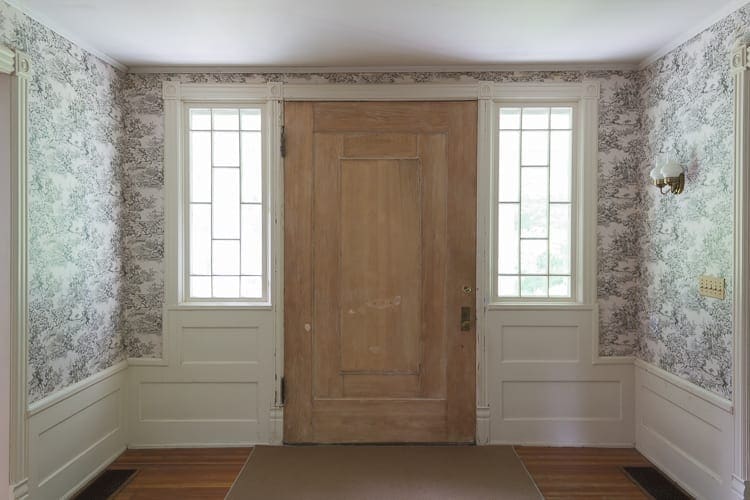 Despite trying everything from the most benign to the most toxic chemical strippers, there is still a shadow of green oil paint in every crevice. We have used a heat gun, dental tools, tiny manual sandpaper tools, and a Dremel. We have spent hours working an inch at a time with small scraps of sandpaper. Our methods have not yielded results that are compatible with staining and varnishing. In fact, in some places, we caused minor damage to the wood instead of creating a clean slate.
Despite trying everything from the most benign to the most toxic chemical strippers, there is still a shadow of green oil paint in every crevice. We have used a heat gun, dental tools, tiny manual sandpaper tools, and a Dremel. We have spent hours working an inch at a time with small scraps of sandpaper. Our methods have not yielded results that are compatible with staining and varnishing. In fact, in some places, we caused minor damage to the wood instead of creating a clean slate.
Through the years, I have spent a lot of time thinking about a solution. This summer, when I pored over all of our before and process photos, I discovered something important. Very important. There is no evidence of stain or varnish on this door anywhere. During the past three summers, we were operating under the assumption that the original finish of this door must have been stain and varnish. I no longer think that is the case. I think this door was painted in thick green oil paint right from the beginning.
Since we started working on the front door three years ago, I have stripped my share of woodwork here in BHH. The interior doors show signs paint over stain. However, other areas in the house indicate the woodwork may have always been painted–specifically the grand staircase. Some of the paint has chipped off down to bare wood, and there is no varnish or stain. The first layer of color appears to be a shade of medium brown.
While we have no interior shots from the 1800s, we do have this exterior photo. To me, it looks like the shingles were natural-colored, and the woodwork was a dark color–probably green, but maybe brown. I wish the lighting was better on that front door!
The March/April 2015 issue of Yankee Magazine published an article that supports the idea that dark green oil paint was available and used during the time that BHH was built.
All of this evidence has honestly kind of rocked my world. Three years ago, I had no idea that some original woodwork was painted from the get-go. If you are interested in learning more, the book, Victorian Interior Decoration: American Interiors, 1830-1900 by Gail Caskey Winkler and Roger W Moss (affiliate link) discusses the trends for painted and unpainted woodwork in-depth. BHH is not classified entirely as a Victorian house, but it is a mish-mash of Colonial, Victorian, and Shingle style trends. In 2017, I wrote two specific posts about our mullet house: Business in the Front, Party in the Back: Part I and Part II. Both of those posts elaborate on the hodgepodge style of BHH.
All this to say, that I think we have decided to paint our front door. We are also considering more hinges and a new doorknob. We need to restore the function of this door, not just the beauty. Right now, it has all sorts of problems. Daylight is visible around the edges. The locks only line up if you give it a solid hip check and pull up on the knob at the same time, but my biggest concern is safety. The door is difficult to open, and the doorknob has fallen off more than once. My daughter is just now strong enough to open it. As a gymnast, she’s no slouch in the strength department either. Being unable to open the door would be dangerous in an emergency.
Currently, I am researching doorknobs and locks. There is a limited selection for our specific configuration which cuts down on the decision-making. Before we change course entirely, I welcome your feedback about this door. For me, painting instead of staining is a significant mind-shift, but I am completely open to the idea. We have been working on this door for three years, so I can wait a few more days to hear you out.
So, let me have it. Or not… If we choose to move forward with the painting, we will start right away. It is going to be cold soon, and the paint needs plenty of time to cure properly. For the exterior side of the door, we would use Heritage Red by Benjamin Moore. Heritage Red is the same color we have used on all of the other doors, including the street side front porch.
We would paint the interior side to match the existing color of the woodwork.

PS: Are there any signs of fall where you live? The air is already crisp here during my early morning dog walks. I’m not ready!



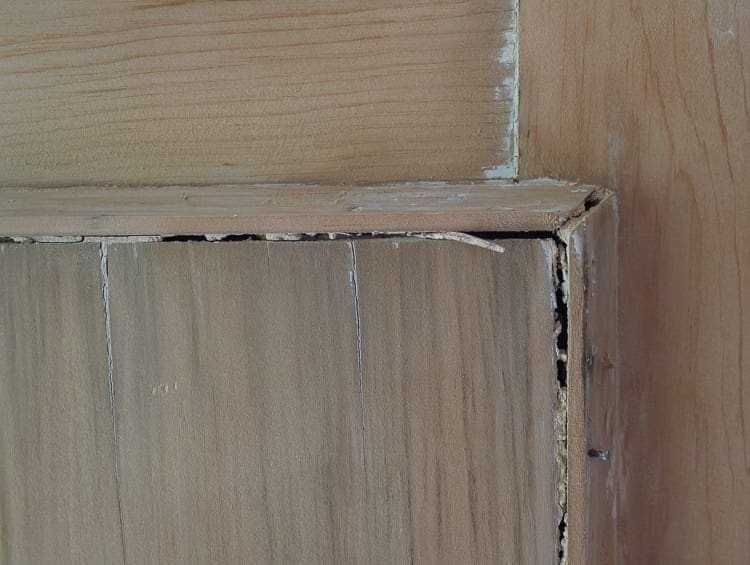
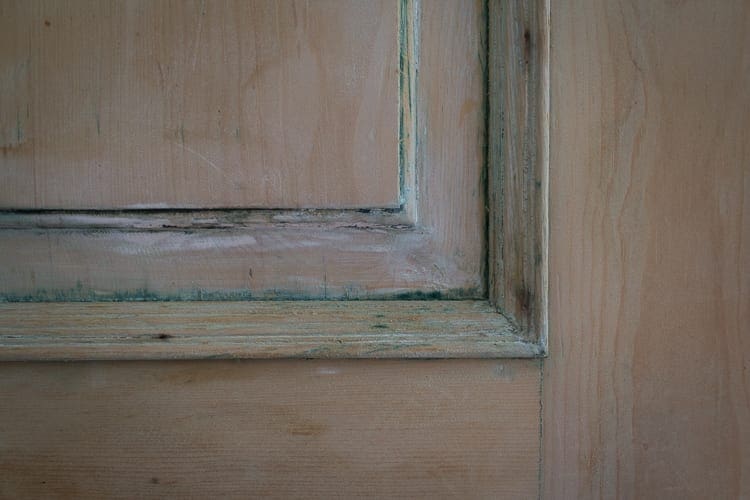


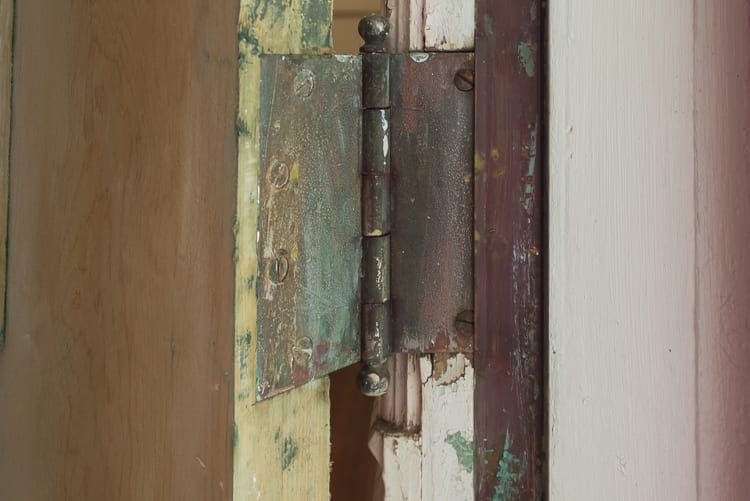
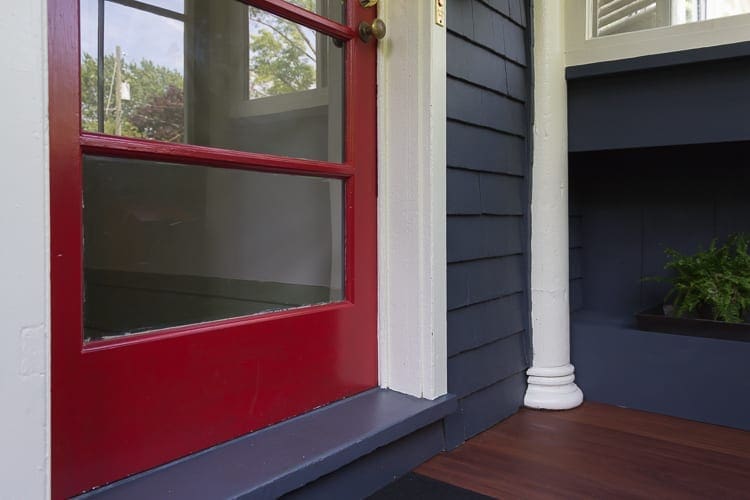

37 Comments
Priscilla Lynch
Paint! Very few older homes had natural wood doors (Craftsman homes and brownstones sometimes did). Paint helped preserve the wood.
Stacy
Thank you, Priscilla!
Ragnar
Same here in Austria. Really, really fancy homes had solid oak doors with a clear finish but something like 90% or even more of the ca.-1900 woodwork was either painted or faux-grained, typically to look like oak. Your brown might actually be the base layer of such a faux finish. Interior trim paint was very often a pale grey (lead paint tends to turn grey as it ages due to sulfur in the air so they didn’t have much truly white paint until at least the 1930s when titanium dioxide became a common white pigment).
First the surface is painted a solid colour, often cream, beige or light brown, sometimes even a surprisingly dark brown. Then the desired wood grain is applied using special graining combs and finally the whole surface is stained. Back in the day there were some seriously skilled artists whose work is nearly impossible to distinguish from real hardwood but today you’re lucky to get something that looks better than wood-grain vinyl from the 70s.
Stacy
I was reading about faux-graining just recently! It is fascinating. I will be looking at our interior woodwork very closely for signs of faux-graining. The more I learn about early building and decorating, the more I want to know. Thank you for your comment. It is wonderfully educational.
Ragnar
Love to hear that! I grew up with faux graining but never quite realised how it was done until I stumbled across a probably defunct blog by a couple named Craig and Yvonne on the renovation of their early-1900s house. They painstakingly re-created the finish on all their interior doors. All the apartment entry doors in the place I live in were faux-grained to look like quarter-sawn oak in a natural finish, a stunning job! Unfortunately two have since been re-painted a solid brown and the others are somewhat worse for wear. Another was re-done after a fire in 2012 and the graining looks HORRIBLE. The interior doors including the inside of the entry doors were light grey or cream from the beginning, as were all the windows. The exterior front door is solid oak – appearances were important in imperial Vienna! That’s also why the first section of stairway is finished with marble halfway up the walls while everything else just has 6″ base tile.
Betsy
Those sidelights are so beautiful……I barely noticed the door….lol
I think I would paint the door.
Stacy
Thank you, Betsy!
Vanessa
No historical advice! Go for the red, it’s perfect.
Stacy
Thanks, Vanessa!
Brenda
yup, paint. When we moved into our WNY house (1860 ish) (the house, not us moving into the house) I figured out some of the wood work was “paint grade”. What a surprise. We switched out some of it, same style, “better” wood, and stained it. It was in horrible shape but a very simple style so I’m not too stressed over it. From where I sit I can see the door to my office/computer room. It has a mostly stripped door on it. I recently figured out that just because we stripped it doesn’t mean we need to stain it. Good thing, as I’m pretty sure it is impossible for the same reasons you mentioned. I grew up with parents who stripped all wood and were discourteous to painters 🙂 They made their annual trek here, driving and camping, from California about a month ago (they are octogenarians). My mom’s favorite find was a painted green cupboard/drawer thing, a real beater. They’ll clean it up and enjoy using it. I figure that gives me permission for all sorts of maybe paint is the answer decisions.
Stacy
I think I want to be your parents when I grow up, except I will be nice to painters. We are tired of painting, and we will need to have them on our side. Ha!
Thank you for your helpful comment. You have a lot of experience with this dilemma, and you have given me something to think about.
Claire
I am in a similar situation, though our front door is smaller, and circa 1925. After lots of stripping, sanding, and Bondo, we got back to a decently clean state, other than traces of maroon paint in the grooves. We decided to use a slightly darker stain than we probably would have chosen if we got all the residue off (Minwax Red Mahogany) with the logic that stain is cheap and easy, and if it looked terrible, we could always prime right over it. It still has a bit of… rustic charm but turned out great. We’ll be finishing it with marine varnish in the fall. Long story short- as long as you are sure you can prime over the stain you use, no harm in trying if you like the look of stain!
Stacy
Thank you for this comment! It sounds like there may be hope. I am going to take a look at the Sikkens product mentioned in another comment before I move forward with paint.
meg@sparrowhaunt.com
I just put on three coats of Sikkins Cetol Door and Window in Mahogany on my entry doors. The finish is deep enough to hide those traces of paint, and appears to be essentially bomb proof in the durability department according to reviews. Just a recommendation if you think you want a stained look instead of paint. Will spring bronze weatherstripping be enough to close the gaps around it? If not, slightly thicker stops (some which come with an integrated gasket) should help
Stacy
Thank you for this recommendation! It looks like Sikkins is sold right down the road, so I will explore this option before paint. I am so glad that you wrote this comment.
To answer your question about spring bronze weatherstripping: We do have that all around. It works in some places but not others. The weight of the door and the house settling has caused some sagging over the years. I am exploring the idea of slightly thicker stops. There is some decorative trim in the upper corners, so I will have to get creative to make that happen.
Jeri
I actually love the idea of painting it especially since it was painted originally. I would feel differently if it had been stained originally. Go for it! 3 years of tireless work is enough. I think the hardware you choose will stand out better with the door painted rather than natural.
Stacy
Thanks, Jeri. I am surprised at how difficult it is to move forward with this change.
Marti
Drop the gavel and pick up the paintbrush!
Stacy
Thanks, Marti!
Chad
I bought salvaged doors for my whole house (it only retained one old door) and at first I planned on painting them. They had some peeling paint with dark alligatored varnish under it, marks from 2 different styles of hardware, and holes, dents and gouges all over them. One of them needed a half inch of damage trimmed off the sides and a splice on the bottom. I reversed which way 2 of them opened and converted 3 to sliding doors. And though there are some bits of paint I never got off, I decided the grain was too pretty to paint, so I stained them all. The damage is still prominent and I don’t mind it a bit. So if you’re really attached to the idea of a stained door, it will look fine even if a bit of the old green paint and damage show.
Stacy
Thanks for weighing in, Chad. I’m going to do a little more research before I make my decision.
Ame Jo Hughes
There’s an olde house in my neighborhood that was converted to apartments and then back to single family, and there are several doors in it that were salvaged from other olds houses that were then demolished. Most of those doors were stripped and then stained, and you can totally see bits of the old paint they couldn’t get all the way off. They all still look amazing. There’s a set of French doors in that house, in fact, that has very little paint stripped off of it – you can see that they attempted it and then said, “screw it, this is steel paint” and only stained the little bit they’d managed to strip. And those doors look amazing. (Shoot me a message if you want to see pics of those, Stacy. I do vote for red paint, but stain WOULD still look awesome.)
JC
I DEFINITELY vote to paint this one. Based on the overall look of the door currently, it looks like it was originally painted, and the resulting stains left in the crevices will be too hard to remove without disassembling and sanding.
As for the lock issue, generally these old locks are better quality than anything new you can buy, and they can generally be repaired. If the issue is more with sagging and the strike plates no longer lining up (making it hard to lock), then I’d suggest either re-fitting (relocating) the strike plates, slighting filing the openings in the plates larger, OR re-fitting the hinges to deepen the slot on the top one, which would have the effect of raising it slightly on the strike side.
If you can find ONE other matching hinge (eBay / Etsy) I’d suggest fitting a third in the centre. I did this with my newly fitted antique door, because A: it weighs 75Lbs, and B: it had a slight bow in the hinge side, which the hinge helped to correct to a certain degree.
For the knob, what kind of setup does your lock use? Is it a square stem with screw-in set-screws, or a threaded square stem, or something else? I have maybe 40-50 antique knobs and some have limited or no use for me, so let me know and I could send you photos of what I have.
Ryan
I also have had to move the latch plate on a door after it would no longer catch due to settling. It’s easier to to that then try to adjust the hinges. And you can get replacement spindles for you knob if the threads are stripped (usually the problem when the knob comes off in your hand. Places like Rejuvenation or House of Antique hardware will sell just the spindle.
I agree that it looks like the door was originally painted. I have a wood finished front door but every other door and bit of trim in the house was originally painted. I’ve seen houses where people have tried to strip all the paint and small bits are always visible in the grain of the wood if there wasn’t varnish there first.
Stacy
Thank you, Ryan. This is very helpful info. Once I get into the doorknob portion of this project, I’ll know more. Your comment will make a good reference.
Stacy
Having you weigh in on this really helps, JC. All of your suggestions are very good. You are correct that it is an issue of sagging that has caused the lock to no longer line up with the strike plates. I never thought about refitting the hinges by deepening the slot on the upper one. Brilliant! You have given me so much to think about. I am going to start looking for a third hinge on eBay per your suggestion.
To answer your question about the knob, I think it is a square stem with set-in screws. However, I have messed with so many doorknobs here that I might be confused. I will get back to you when I get to that step in the project.
Devyn
Front Door: “Paint me please…. I am feeling very vulnerable hanging out here while naked.”
While there were certainly Victorian front doors with just a stain and varnish, they were more often found on Italianate Victorians. I believe yours was more likely painted, and in a nice glossy enamel. The red is certainly keeping within the confines of the period as well.
As for the inside… I think it all depends on where you plan to go with your reception hall. If it will be a while before you delve into updating the reception hall (assuming you will be doing so), then it might make sense to just prime and paint it to match the off white you currently have. It is a relatively easy fix to change in the future.
Stacy
Haha! I love it. If that door could talk…
I agree with you on the interior color for the door. The trim all around it needs a good scrub and touch-up.
Devyn
I forgot to add that House of Antique Hardware has a nice selection of reproduction Victorian entry door sets. They are a bit pricey, but this isn’t just an ordinary door.
https://www.houseofantiquehardware.com/front-door-hardware
Also, I am really surprised there are only two hinges with four screws each holding what is probably at least 200 lbs of swinging fabulosity. I will be curious to find out how long those slotted brass screws holding the hinges in place are.
(Please feel free to delete the above comment I accidentally left on the linked post. ? )
Stacy
I love House of Antique Hardware. I’m willing to shell out the bucks in certain situations. ?
I cannot believe there are only two hinges either, and I have no idea how long the screws are. They are probably not long enough. I’ll keep you posted!
PS: Comment deleted!
Ame Jo Hughes
I vote paint that baby red!
Now, to be clear, if that door had windows in it, I’d be firmly in the “presevere and stain it” camp. Dunno why, I just like doors with windows to be stained. But no windows AND you’ve been killing yourselves stripping it?! Yeah, paint it. It’ll look amazing.
One of our doors needs to be hip checked to latch and lock as well (but it’s due to the rubber gasket I put around it to cut down on the drafts – sunlight on all three sides of the thing). Old house quirks are fun sometimes, but not so much when safety comes into play.
Stacy
Thanks for your comments, Ame. If you are willing to send photos of the doors that you described, I would like to see them.
SH
Since This Old House magazine is now aware of BHH and your ongoing restoration, perhaps someone there has some suggestions, tips, or products that can help with paint removal, or has insight on staining vs painting this door.
Stacy
That is a good suggestion, SH.
Stacey @ Poofing the Pillows
This whole space is just fabulous and that door is a knockout! Now that you think it was painted originally, I say go for it! Make it your dream door.
Stacy
This new knowledge certainly takes the pressure off. Thanks, Stacey!